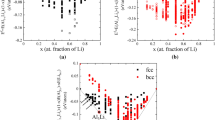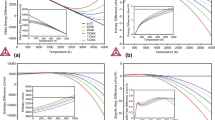Abstract
Consistent sets of thermodynamic functions for the Al-Ta system are obtained by a computer-operated least squares method applied to all of the experimental phase diagram and thermodynamic data from the literature. Special attention is paid to the σ phase, AlTa2, which is described by a sublattice model, (Al,Ta)10Ta4(Ta,Al)16, in a final treatment. The other phases are modeled with the Redlich-Kister formula [liquid, fcc (Al), and bcc (Ta)] or as stoichiometric compounds (Al3Ta, Al69Ta39, Al3Ta2, Al7Ta5, and AlTa).
Four treatments are performed. In the first and second treatments, which differ by whether or not the experimental partial Gibbs energy data of Al in bcc (Ta) are used, AlTa2 is assumed to be a stoichiometric compound; in the third and final ones, it is described by sublattice models (Al,Ta)1Ta2 and (Al,Ta)10Ta4(Ta,Al)16, respectively. Data on the partial Gibbs energy of Al in bcc (Ta) are not consistent with solid solubility data of Al in bcc (Ta). In the second, third, and final treatments, this step-by-step modeling procedure provides reliable estimates and useful starting values for the parameters at each of the higher levels. In addition, the complete and consistent thermodynamic functions of the second or third treatments may be useful for a simplified description of the Al-Ta system if less accuracy for the σ phase is required. A comparison with other σ phase descriptions in the literature suggests some benefits of the model used in the final treatment. It covers a broad composition range. It is supported by the crystal structure, and it uses a small number of adjustable parameters.
Similar content being viewed by others
Cited References
G. Brauer, “Crystal Structures of the Intermetallic Compounds of Al with Ti, Zr, Th, Nb, and Ta,”Naturwissenschaften, 26, 710 (1938) in German.
G. Brauer, “About the Crystallographic Data of TiAl3, NbA3, TaAl3, and ZrAl3,” Z.Anorg. Allg. Chem., 242(1), 1–22 (1939) in German.
O. Redlich and A.T. Kister, “The Algebraic Representation of Thermodynamic Properties and the Classification of Solutions,”Ind. Eng. Chem., 40,345–348 (1948).
C. Wagner,Thermodynamics of Alloys, Addison-Wesley Press Inc., Cambridge, MA (1952).
V.M. Glazov, M. V. Mal’tsev, and Y.D. Chistyakov, “Aluminum- Tantalum Equilibrium Diagram,”Izv. Akad. NaukSSSR, Otdel. Tekh. Nauk,4,131–136(1956)in Russian.
V.M. Glazov, G.P. Lazarev, and G.A. Korol’kov, “The Solubility of Some Transition Metals in Aluminum,”Metalloved. Term. Obrab. Met, 10,48–50 (1959) inRussian.
L.E. Edshammar and B. Holmberg, “The Sigma Phase Ta2Al,”ActaChem. Scand., 14(5), 1219–1220(1960).
K.P. Gupta, “Sigma Phases with Aluminum,”Trans. AIME, 227(10), 1047–1049(1961).
H. Nowotny, C. Brukl, and F. Benesovsky, “Investigation about the Ta-Al-Si and W-Al-Si Systems,”Mh. Chem., 92(1), 116–127 (1961) in German.
H.A. Wilhelm and J.H. Witte, “Aluminum-Tantalum Alloy Stud- ies,” Report No. IS-500, M48 U.S. Atomic Energy Commission (1962).
K. Schubert, H.G. Meissner, A. Raman, and W. Rossteutscher, “Crystallographic Data for Some Metallic Phases,”Naturwissen- schaften, 51(12), 287 (1964) in German.
A. Raman, “About the Tantalum-Aluminum System,”Alu- minium, 41 (5), 318–319 (1965) in German.
W.W. Beaver, A.J. Stonehouse, and R.M. Paine, “Development of Intermetallic Compounds for Aerospace Applications,”Plansee Proceedings, Metalwerk Plansee AG, Reutte/Tyrol, Austria, 682–699 (1965).
R.H. Willens and E. Buehler, “Rapid Quenching of Reactive and Refractory Alloys from the Liquid State,”Trans. AIME, 236(2), 171–174(1966).
P. Kofstad and S. Espevik, “Oxidation of Tantalum Coated with Aluminum and Aluminum-Chromium Alloys,”J. Less-Common Met., 12(2), 117–138(1967).
A. Neckel and H. Nowotny, “The Thermochemistry of Alu- minides,”5th Internationale Leichmetalltang, 95, 72–76 (1969) in German.
K. Girgis and A.B. Harnik, “ANew Phase Ta2Al3,”Naturwissen- schaften, 57(5),242(1970).
M. Hillert and L.I. Staffansson, “Regular Solution Model for Stoichiometric Phases and Ionic Melts,”Acta Chem. Scand., 24, 3618–3626(1970).
H. Kimura, O. Nakano, and T. Ohkoshi, “Aluminum-Tantalum System,”Keikinzoku, 23(3), 106–112(1973)inJapanese.
A. Schauer, M. Roschy, and W. Juergens, “Dielectric Properties of Anodized Aluminum-Tantalum Alloy Films with High AluminumContent,” Thin Solid Films, 27,(1), 111–121 (1975).
P.W. Brown and F. J. Worzala, “Resistivity and Lattice Parameter Variations in Nd2Al Type Sigma Phases,”J. Mater. Sci., 77(4), 760–766(1976).
V.N. Yeremenko, Y V. Natanzon, and V.I. Dybkov, “Interaction of the Refractory Metals with Liquid Aluminum,”J. Less-Common Met., 50,29–48(1976).
C.G. Wilson and F.J. Spooner, “Order in NbAl and TaAl Type σ Phases,”J. Mater. Sci., 12,1653–1658(1977).
S.P. Yatsenko and M.P. Skachkov, “The Solubility of Tantalum in Liquid Aluminium,”Th. Fiz. Khim., 51(5), 1274 (1977) in Russian; TR:Russ.J. Phys. Chem., 51(5),755 (1977).
G.I. Nikolaev and N. V. Bodrov, “Study by Atomic Absorption of the Evaporation of Aluminium Impurities from Tantalum and Nio- bium,”Th. Fiz. Khim., 52, 1430–1433 (1978) in Russian; TR:Russ. J. Phys. Chem., 52(6), 821–822 (1978).
O. Kubaschewski, “An Empirical Estimation of the Henrian Constants of Dilute Metallic Solutions,”High Temp.—High Press., 75,435–440(1981).
B. Sundman and J. Agren, “A Regular Solution Model for Phases with Several Components and Sublattices, Suitable for Computer Applications,”J. Phys. Chem. Solids, 42(4), 297–301 (1981).
A.F. Guillermet, “An Assessment of the Fe-Mo System,”Cal- phad, 6(2), 127–140(1982).
J.-O. Andersson, “A Thermodynamic Evaluation of the Fe-V System,”Calphad, 7(4),305–315(1983).
J.C. Schuster, “Phases and Phase Relations in the System Tanta- lum-Aluminum,”Z. Metallkd. 76(11),724–726(1985).
B. Sundman, B. Jansson, and J.-O. Andersson, “The THERMO-CALC Databank System,”Calphad, 9(2), 153–190 (1985).
S.R. Schmidt and H.F. Franzen, “Enthalpies of Formation in the Tantalum-Sulfur and Tantalum-Aluminum Systems,”J. Less-Com- mon Met., 776(1), 73–82(1986).
J.-O. Andersson and B. Sundman, “Thermodynamic Properties of the Cr-Fe System,”Calphad, 11 (1), 83–92(1987).
S. Singh, S. Lele, and C. Suryanarayana, “Microstructural Char- acterization of Rapidly Solidified Al-Ta Alloys,”Metall. Trans. A, 78(11), 1915–1922(1987).
V.S. Sudavtsova and G.I. Batalin, “Enthalpies of Formation of Liquid Alloys of the Aluminum-(Tantalum, Tungsten) Systems,”Ukr. Khim. Zh., 55(2), 144–145 (1989) in Russian.
PR. Subramanian, D.B. Miracle, and S. Mazdiyasni, “Phase Re- lationships in the Al-Ta System,”Metall. Trans. A, 27(3), 539–545 (1990).
C.A. Coughanowr, I. Ansara, R. Luoma, M. Hamalainen, and H.L. Lukas, “Assessment of the Cu-Mg System,”Z Metallkd., 82(7), 574–581 (1991).
A.T. Dinsdale, “SGTE DATA for Pure Elements,”Calphad, 75(4), 317–425 (1991).
W.M. Huang, “A Thermodynamic Analysis of the Mn-V andFe- Mn-V Systems,”Calphad, 75(2), 195–208(1991).
L. Kaufman, “Coupled Thermochemical and Phase Diagram Data for Tantalum Based Binary Alloys,”Calphad, 75(3), 243–259 (1991).
P. Villars and L.D. Calvert,Pearson’s Handbook of Crystal- lographic Data for Intermetallic Phases, ASM International, Materi- als Park, OH 44073 (1991).
M.S. El-Eskandarany, K. Aoki, and K. Suzuki, “Calorimetric and Morphological Studies of Mechanically Alloyed Al-50 at% Transi- tion Metal Prepared by the Rod-Milling Technique,”J. Appl. Phys., 72(7), 2665–2672 (1992).
S. Jiang, J. Zou, D.J.H. Cockayne, A. Sikorski, A. Hu, and R.W. Peng, “An Electron Diffraction and Microscopy Investigation of Quasi-Periodic Ta-Al Superlattices,”Philos. Mag.B, 66(2), 229–237 (1992).
V.N. Kot’kin, S.N. Nesterenko, and L.I. Meshkov, “The Al-Hf- Ta Phase Diagram,”Vestn. Most Univ., Ser. 2: Khim., 33(2), 188–189 (1992)in Russian.
M.L. Weaver and M.J. Kaufman, “An Investigation of Al2Ta and Related Phases in the Ternary Al-Ta-Ti System,”Scr. Metall. Ma- ter.,26(3)411–416 (1992).
“SGTE Solution Database 1992,” Royal Institute of Technol- ogy, Sweden (1992).
J.G. Costa Neto, S.G. Fries, H.L. Lukas, S. Gama, and G. Effen- berg, “Thermodynamic Optimization of the Nb-Cr System,”Cal- phad, 17(3),219–228 (1993).
S. Mahne, F. Krumeich, and B. Harbrecht, “Phase Relations in the Aluminum-Tantalum System: on the Translational Symme- tries of Al3Ta2 and AlTa,”J. Alloy. Compd., 207(1-2), 167–174 (1993).
S.V. Meschel and O.J. Kleppa, “Standard Enthalpies of Forma- tion of 5d Aluminides by High-Temperature Direct Synthesis Cal- orimetry,”.J. Alloy. Compd., 1797(1), 75–81 (1993).
S. Mahne and B. Harbrecht, “Al69Ta39 - a New Variant of a Face-Centered Cubic Giant Cell Structure,”J. Alloy. Compd, 203(1- 2),271–279(1994).
S. Mahne, B. Harbrecht and F. Krumeich, “Phase Relations in the Al-Ta System: on the Translational Symmetries of a Triclinic Structure and a New Hexagonal Giant Cell Structure,”J. Alloy. Compd., 218(2), 177–182(1995).
D.B. Miracle, F. Scheltens, and P.R. Subramanian, “Crystal Structure Determination of Al2Ta,”Philos. Mag. B, 77(5), 941–953 (1995).
B. Harbrecht, “Solution Range of the σ-AlTa2 Phase,” Internal Report, University of Bonn, Germany (1996).
M. Palm, W. Sanders, and G. Sauthoff, “Phase Equilibria in the Ni-Al-TaSystem,”Z Metallkd., 87(5), 390–398 (1990).
J.C.Schuster, Melting Point of Al3Ta, private communication (1996).
Author information
Authors and Affiliations
Rights and permissions
About this article
Cite this article
Du, Y., Schmid-Fetzer, R. Thermodynamic modeling of the Al-Ta system. JPE 17, 311–324 (1996). https://doi.org/10.1007/BF02665557
Received:
Published:
Issue Date:
DOI: https://doi.org/10.1007/BF02665557




